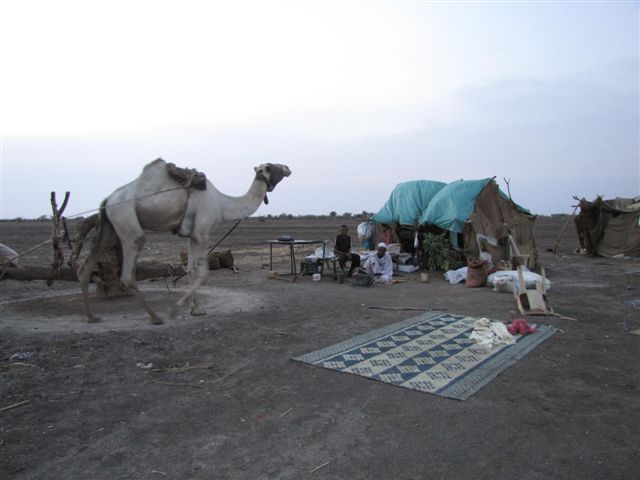Every time we've been out on the highway, about 50kms/31miles from Khartoum, we pass scenes such as above. People with a nomadic style home, a prayer mat, and a camel circling container in the center.
Last week, we stopped and I got out to chat to these gentlemen above.
I greeted the older man and he told me the young lad with him was his son. I asked if I could take photos of his home and the camel. He agreed. I asked him what he was grinding in the motar to which he replied "sim-sim". Sesame seeds? I was surprised. I thought he was grinding wheat for flour. No, he told me he was producing sesame seed oil. Then he showed me a pod with seeds in it and brought out the oil he'd already produced that morning.
A Sudanese gentleman and his son live in this nomadic - style tent. The camel sleeps behind the tent
The camel is attached to a pulley with the pestle grinding the sesame seed inside the motar
The camel is blindfolded so that it is not distracted from the job it is doing
Sesame seed which has been harvested and waiting to be ground
Sesame seed is the dried seed of Sesamum indicum. High in protein, the seeds are oval shaped and have a nutlike flavor when toasted. Sesame was native to Indonesia and eastern and Northern Africa. The ancient Babylonians used sesame seeds to make cakes, to flavor wine and brandy, and to provide oil for both cooking and perfuming purposes. By 1500 bc the Egyptians were using sesame oil as a medicine. The peoples of the Bible would have used sesame seeds in their cooking.
The indigenous peoples of Africa and Asia treat sesame seeds as a grain, but in Europe, Japan, and the Americas, sesame has entered the diet as cooking oil. In recent years sesame seeds have been used to flavor breads, crackers, and salad dressings.
In folklore, the magical password “Open Sesame” that unlocked the cave for Ali Baba in The Thousand and One Nights probably was a play on the fact that ripe sesame seed pods pop open loudly with a slight touch. Also, sesame seed was so common that “sesame” would not have been considered important enough to be used as a secret password.
The Sudanese farmer holds up the finished product
In modern Sudan, sesame seeds are ground with a pestle and mortar. Photographed (top) a camel, attached to the pestle which grinds the seeds, walks endlessly around the container/motar. Then the ground seed is placed on a stone, clay or gourd slab and kneaded by hand into a paste before extraction.
The pulp is added to water and boiled at a high temperature. The oil floats to the top, scooped off in a shallow dish and reheated to remove the last of the water. Half a kilogram of sesame seed produces 108ml of oil so it is a long and laborious process.
I was privileged to be able to photograph the camel (which is blindfolded to keep it on course), the two men and their home in the desert.
As this post is aired this morning, we will be travelling into the desert again. When we pass this man's camp, we will stop and give them prints of the photos which I took of them.
The Arabic for sesame oil is Zyt as-Smsm (zeet-a-simsim)
Source: Some Internet
Other: Mine own






What a tiring process! I learn something new always from you! I love those sesame candy crunch! And anything with them is delicious! God bless and keep you. Have a great weekend sister.
ReplyDeleteThis is great Jo! No wonder sesame oil is so expensive. I look forward to your next desert adventure. Have fun!
ReplyDeleteVery interesting and labour intensive process. Boiling the paste reminds me of the process used in West Africa to make shea butter. I use and appreciate both sesame oil for cooking and shea butter as a moisturizing skin treatment.
ReplyDeleteWhat a laborious task! Hope the camel doesn't get dizzy - ha!
ReplyDeleteI really enjoy your adventures and interesting posts :)
☼ Sunny
How utterly fascinating. I have never thought about how sesame oil is made - and certainly never given the origins of Open Sesame a thought either. Thanks. And thanks for the comments on my blog - enjoy your desert meanderings. I look forward to the next installment.
ReplyDeleteSee that's so nice to read how people really live these things I wouldn't find in a travel magazine !
ReplyDeleteJo, so interessant!! En lieflike foto's daarby. Dit is nou rêrig iets waarvan ek nog nooit van gehoor het nie. Arme kameel - 'n mens moet hom seker beskou as 'n werkdier wat goeie versorging kry, maar die 'blinddoekery' lyk erg...
ReplyDeleteInteresting! No wonder sesame oil is so expensive.
ReplyDeleteI need to catch up with your blog posts. Been busy these past few days. I wish I could spend more time with blogging and blog hopping.
Have a great start of the week Jo. Regards to your husband.
This was very interesting, Jo! I especially liked the background info about the phrase, "Open, Sesame."
ReplyDeleteI wonder what motivates the camel to keep walking in a circle for so long. I'd have thought it would stop. But I guess it would be boring to just stand still, and besides, camels are used to walking long distances. Sesame oil produced by camelpower rather than horsepower--amazing!